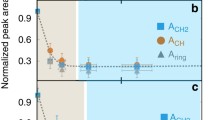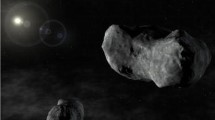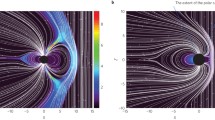Abstract
Discharge experiments produce amino acid distributions that are similar to distributions observed in carbonaceous meteorites (Oró, 1990). A recent work (Desch and Cuzzi, 2000) points out to the presence of lightning in the Solar Nebula. Magnetic measurements of chondrules reveal extraordinary magnetic acquisitions (Wasilewski and Dickinson, 2000) that can be explained simply by a presence of magnetic fields generated by lightning discharge (Wasilewski and Kletetschka, 1999). Thus we speculate that lightning discharge may be responsible for the origin of amino acid compounds in carbonaceous meteorites.
Access this chapter
Tax calculation will be finalised at checkout
Purchases are for personal use only
Similar content being viewed by others
7. References
Desch, S. J., and Cuzzi, J. N., (2000), The generation of lightning in the solar nebula. Icarus, 143, 87–105.
Oró, J., (1990), The origin and early evolution of life on Earth. Annu. Rev. Earth Planet. Sci., 18, 317–356.
Sugiura, N., and Strangway, D. W., (1988), Magnetic Studies of Meteorites. in J. F. Kerridge, M. S. Matthews, Meteorites and the early solar system: Tuscon, US, Univ. Ariz. Press, 595–615.
Wasilewski, P., and Kletetschka, G., (1999), Lodestone — Natures Only Permanent Magnet, what it is and how it gets charged. Geophysical research letters, 26, 2275–2278.
Wasilewski, P., and Dickinson, T., (2000), Aspects of the validation of magnetic remanence in meteorites. Meteoritics and Planetary Science, 35, 537–544.
Author information
Authors and Affiliations
Editor information
Editors and Affiliations
Rights and permissions
Copyright information
© 2001 Springer Science+Business Media Dordrecht
About this paper
Cite this paper
Kletetschka, G. (2001). Electric Discharge in Carbonaceous Meteorites?. In: Chela-Flores, J., Owen, T., Raulin, F. (eds) First Steps in the Origin of Life in the Universe. Springer, Dordrecht. https://doi.org/10.1007/978-94-010-1017-7_29
Download citation
DOI: https://doi.org/10.1007/978-94-010-1017-7_29
Publisher Name: Springer, Dordrecht
Print ISBN: 978-94-010-3883-6
Online ISBN: 978-94-010-1017-7
eBook Packages: Springer Book Archive




